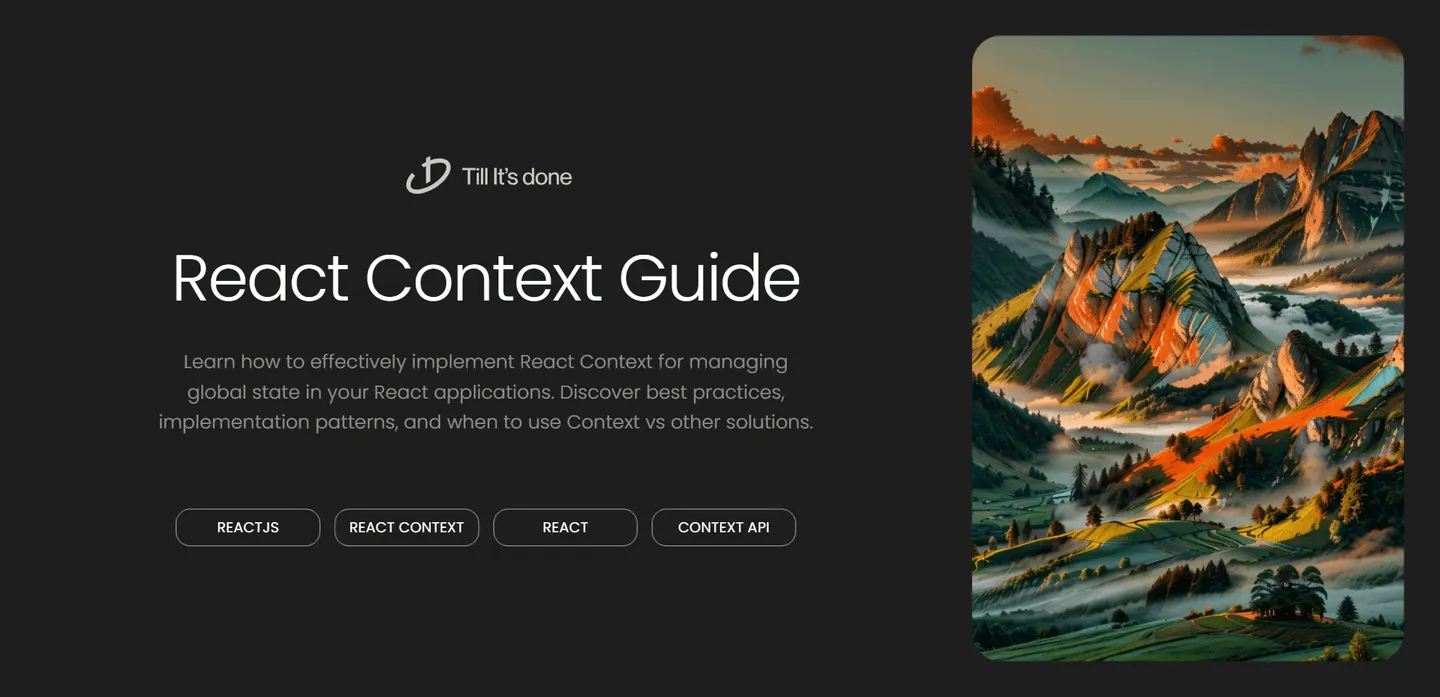- Services
- Case Studies
- Technologies
- NextJs development
- Flutter development
- NodeJs development
- ReactJs development
- About
- Contact
- Tools
- Blogs
- FAQ
Use React Context for Global State Management
Discover best practices, implementation patterns, and when to use Context vs other solutions.

How to Use React Context for Global State Management

Managing state in React applications can become complex as your app grows. While props are great for passing data between components, they can lead to “prop drilling” when you need to pass data through multiple levels of components. This is where React Context comes in – it’s like a magical tunnel that lets you beam data directly to where it’s needed, without passing through every component in between.
Understanding React Context
Think of React Context as a broadcast system in your React app. Instead of manually passing props down through each component, Context lets you create a central data store that any component can tap into. It’s perfect for global data like user preferences, themes, or authentication status.

Setting Up Context
Creating and using Context involves three main steps:
- Create a Context using
React.createContext() - Provide the Context value using a Provider component
- Consume the Context in child components
Here’s a practical example of implementing a theme switcher:
import { createContext, useState } from 'react';
export const ThemeContext = createContext();
export function ThemeProvider({ children }) { const [isDark, setIsDark] = useState(false);
return ( <ThemeContext.Provider value={{ isDark, setIsDark }}> {children} </ThemeContext.Provider> );}Consuming Context
The beauty of Context is how easily components can consume it. Using the useContext hook, any component can access the Context values:
import { useContext } from 'react';import { ThemeContext } from './ThemeContext';
function ThemedButton() { const { isDark, setIsDark } = useContext(ThemeContext);
return ( <button onClick={() => setIsDark(!isDark)}> Switch to {isDark ? 'Light' : 'Dark'} Theme </button> );}
Best Practices
-
Context Composition: Split your Context into logical domains rather than having one giant Context for everything. This makes your code more maintainable and prevents unnecessary re-renders.
-
Performance Considerations: Remember that all components consuming a Context will re-render when the Context value changes. Structure your Context values to minimize unnecessary updates.
-
Default Values: Always provide meaningful default values when creating Context. This makes your Context more reusable and helps with testing.
When to Use Context
Context is perfect for:
- Theme settings
- User authentication state
- Language preferences
- Shopping cart state
- Any global app state that many components need to access
However, it’s not always the best solution. For simple parent-child communication, props are still the way to go. And for complex state management with frequent updates, you might want to consider Redux or other state management libraries.

With React Context, you can write cleaner, more maintainable code by avoiding prop drilling and maintaining a single source of truth for your global state. Start small, experiment with simple use cases, and gradually expand your usage as you become more comfortable with the Context API.
Remember: Context is not a replacement for all state management – it’s another tool in your React toolbox. Use it wisely, and your code will thank you for it!
 สร้างเว็บไซต์ 1 เว็บ ต้องใช้งบเท่าไหร่? เจาะลึกทุกองค์ประกอบ website development cost อยากสร้างเว็บไซต์แต่ไม่มั่นใจในเรื่องของงบประมาณ อ่านสรุปเจาะลึกตั้งแต่ดีไซน์, ฟังก์ชัน และการดูแล พร้อมตัวอย่างงบจริงจาก Till it’s done ที่แผนชัด งบไม่บานปลายแน่นอน
สร้างเว็บไซต์ 1 เว็บ ต้องใช้งบเท่าไหร่? เจาะลึกทุกองค์ประกอบ website development cost อยากสร้างเว็บไซต์แต่ไม่มั่นใจในเรื่องของงบประมาณ อ่านสรุปเจาะลึกตั้งแต่ดีไซน์, ฟังก์ชัน และการดูแล พร้อมตัวอย่างงบจริงจาก Till it’s done ที่แผนชัด งบไม่บานปลายแน่นอน  Next.js สอน 14 ขั้นตอนเบื้องต้น: สร้างโปรเจกต์แรกใน 30 นาที เริ่มต้นกับ Next.js ใน 14 ขั้นตอนเพียงแค่ 30 นาที พร้อม SSR/SSG และ API Routes ด้วยตัวอย่างโค้ดง่าย ๆ อ่านต่อเพื่อสร้างโปรเจ็กต์แรกได้ทันทีที่นี่
Next.js สอน 14 ขั้นตอนเบื้องต้น: สร้างโปรเจกต์แรกใน 30 นาที เริ่มต้นกับ Next.js ใน 14 ขั้นตอนเพียงแค่ 30 นาที พร้อม SSR/SSG และ API Routes ด้วยตัวอย่างโค้ดง่าย ๆ อ่านต่อเพื่อสร้างโปรเจ็กต์แรกได้ทันทีที่นี่  วิธีสมัคร Apple Developer Account เพื่อนำแอปขึ้น App Store ทีละขั้นตอน อยากปล่อยแอปบน App Store ระดับโลก มาอ่านคู่มือสมัคร Apple Developer Account พร้อมเคล็ดลับ TestFlight และวิธีอัปโหลดที่ง่ายในบทความเดียวนี้ได้เลย
วิธีสมัคร Apple Developer Account เพื่อนำแอปขึ้น App Store ทีละขั้นตอน อยากปล่อยแอปบน App Store ระดับโลก มาอ่านคู่มือสมัคร Apple Developer Account พร้อมเคล็ดลับ TestFlight และวิธีอัปโหลดที่ง่ายในบทความเดียวนี้ได้เลย  TypeScript Interface คืออะไร? อธิบายพร้อมวิธีใช้และข้อแตกต่างจาก Type เรียนรู้วิธีใช้ TypeScript Interface เพื่อสร้างโครงสร้างข้อมูลที่ปลอดภัยและเข้าใจง่าย พร้อมเปรียบเทียบข้อดีข้อแตกต่างกับ Type ที่คุณต้องรู้ ถูกรวมเอาไว้ในบทความนี้แล้ว
TypeScript Interface คืออะไร? อธิบายพร้อมวิธีใช้และข้อแตกต่างจาก Type เรียนรู้วิธีใช้ TypeScript Interface เพื่อสร้างโครงสร้างข้อมูลที่ปลอดภัยและเข้าใจง่าย พร้อมเปรียบเทียบข้อดีข้อแตกต่างกับ Type ที่คุณต้องรู้ ถูกรวมเอาไว้ในบทความนี้แล้ว  Material-UI (MUI) คืออะไร อยากสร้าง UI สวยงามและเป็นมืออาชีพในเวลาอันรวดเร็วใช่ไหม มาทำความรู้จักกับ Material-UI (MUI) ที่ช่วยให้คุณพัฒนาแอปพลิเคชันบน React ได้ง่ายและดูดีในทุกอุปกรณ์
Material-UI (MUI) คืออะไร อยากสร้าง UI สวยงามและเป็นมืออาชีพในเวลาอันรวดเร็วใช่ไหม มาทำความรู้จักกับ Material-UI (MUI) ที่ช่วยให้คุณพัฒนาแอปพลิเคชันบน React ได้ง่ายและดูดีในทุกอุปกรณ์  เปรียบเทียบ 3 วิธีติดตั้ง install node js บน Ubuntu: NVM vs NodeSource vs Official Repo แบบไหนดีที่สุด? เรียนรู้วิธีติดตั้ง Node.js บน Ubuntu ด้วย NVM, NodeSource หรือ Official Repo เลือกวิธีที่เหมาะกับความต้องการของคุณ พร้อมเปรียบเทียบ เพื่อการพัฒนาที่มีประสิทธิภาพ!
เปรียบเทียบ 3 วิธีติดตั้ง install node js บน Ubuntu: NVM vs NodeSource vs Official Repo แบบไหนดีที่สุด? เรียนรู้วิธีติดตั้ง Node.js บน Ubuntu ด้วย NVM, NodeSource หรือ Official Repo เลือกวิธีที่เหมาะกับความต้องการของคุณ พร้อมเปรียบเทียบ เพื่อการพัฒนาที่มีประสิทธิภาพ! พูดคุยกับซีอีโอ
We'll be right here with you every step of the way.
We'll be here, prepared to commence this promising collaboration.
Whether you're curious about features, warranties, or shopping policies, we provide comprehensive answers to assist you.


